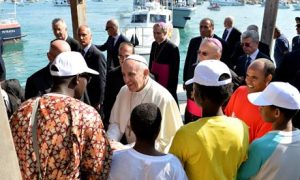Italian election sees return of ‘refugee politics’
Europe’s refugee crisis looks set to be weaponised by Italy’s far-right as the nation’s election looms.
Just days after the downfall of Italy’s last government, Matteo Salvini, leader of the far-right League party, began targeting refugees.
First up were a series of social media posts featuring purported crimes by what he described as “fake refugees”.
Since then, Salvini, a former interior minister notorious for moves to block the arrival of asylum seekers in Italian ports, turned up in Lampedusa.
Lampedusa, in the central Mediterranean, has recently been the site of refugee boat landings that has stretched the capacity of its reception centre.
“Italy is not the refugee camp of Europe. This is shameful. But Italians will soon vote and can turn a page,” Salvini posted.
As political rallies get underway, it’s clear the refugee crisis is back and the far-right is keen to capitalise on it in the election, due on September 25.
A coalition led by Brothers of Italy, a descendant of the neo-fascist Italian Social Movement (MSI), Salvini’s far-right League and Silvio Berlusconi’s Forza Italia is expected to win.
The coalition’s candidate for Prime Minister is Brothers of Italy’s Giorgia Meloni, who could become the country’s first far-right leader since Mussolini.
He once said Italy should “repatriate the migrants back to their countries and then sink the boats that rescued them”.
The focus on migrants and Lampedusa is working for the right in Italy. In the 2019 EU elections, the League won almost 46 per cent of votes and last year, the residents of the island, who have accused the Italian government of abandoning them, elected a League deputy mayor.
The use of a refugee crisis is nothing new in Italian politics.
At the height of Europe’s refugee crisis in 2015, more than 21,000 asylum seekers landed in Lampedusa. The island, known for its crystalline waters, was already the main port of arrival for migrants, and the tragic scene of deaths at sea.
Two years earlier, a fishing boat carrying 440 asylum seekers from Eritrea and Somalia capsized after a fire broke out.
At least 368 people died. Pictures of hundreds of coffins in rows in a hangar on the island were published around the globe.
 As Hungary, Greece and Croatia enacted draconian measures to impede the movement of asylum seekers, film directors, actors, prime ministers and even The Pope began to visit Lampedusa to see Europe’s compassionate side.
As Hungary, Greece and Croatia enacted draconian measures to impede the movement of asylum seekers, film directors, actors, prime ministers and even The Pope began to visit Lampedusa to see Europe’s compassionate side.
The island became a global example of reception and humanity. Migrants were free to walk on the island without any problem. Rescue operations were led by Mare Nostrum, a military intervention for humanitarian ends launched by Italian authorities intended to prevent tragedies.
Asylum seekers were rescued at sea and transferred safely to Italy before being moved on to destinations across Europe.
But it didn’t last. The far-right depicted the arrival of asylum seekers as “an invasion”.
Mare Nostrum was replaced by Operation Triton, which was intended to patrol the Mediterranean more than save lives.
In an attempt to stem the flow, Italy struck a deal with the Libyan coastguard that allowed it to return asylum seekers to a country where they suffer torture and abuse.












